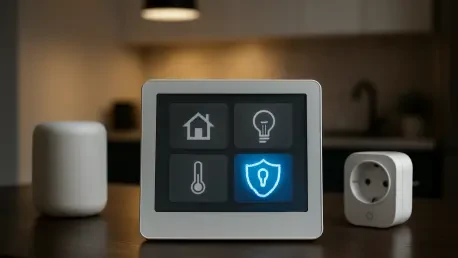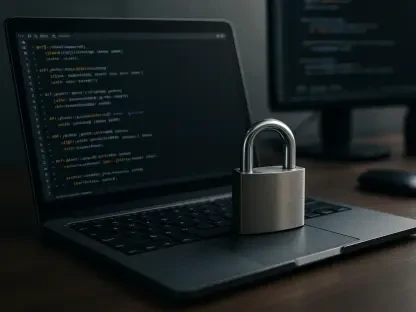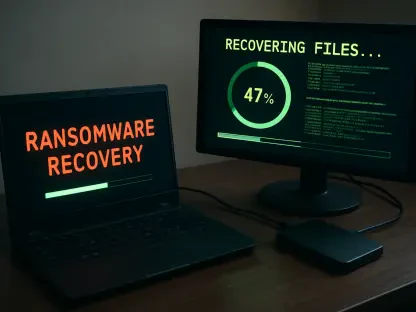Fixed version:
In an era where homes are becoming increasingly connected through smart devices, the risk of cyber threats looms larger than ever, particularly for high-net-worth individuals whose residences often double as workspaces, making them prime targets for hackers. Imagine a scenario where a hacker gains access to a luxury home’s network through a seemingly harmless smart thermostat, not only compromising personal data but also opening a backdoor to a corporate system with millions at stake. This isn’t a distant possibility but a pressing reality that smart home integrators must confront. At a recent industry panel, experts underscored the alarming vulnerabilities introduced by the proliferation of Internet of Things (IoT) devices and the sophisticated tactics of cybercriminals. Their message was unequivocal: integrators must prioritize cybersecurity to protect their clients and safeguard their own professional reputation in a landscape where breaches can have devastating consequences.
The Growing Threat Landscape for Connected Homes
Escalating Risks with IoT Proliferation
The rapid expansion of IoT devices in modern homes has created a double-edged sword, offering convenience while simultaneously exposing significant security gaps that hackers are eager to exploit. From smart door locks to connected appliances, these devices often lack robust built-in security, making them easy targets for malicious actors. Industry specialists have pointed out that as nearly 60% of executives now work from home, the boundary between personal and corporate networks has blurred, amplifying the potential impact of a breach. A single compromised device in a residential setting can serve as a gateway to sensitive business data, leading to financial losses in the millions. This vulnerability is compounded by the fact that cyber threats often remain invisible until it’s too late, making it challenging for clients to recognize the urgency of protection without expert guidance. Integrators, therefore, find themselves at the forefront of a battle to secure these interconnected environments against increasingly cunning attacks.
Innovative Attack Methods and Real-World Impacts
Beyond the sheer number of connected devices, the creativity and audacity of cybercriminals pose a unique challenge that integrators must address with urgency and innovation. Hackers have been known to employ advanced techniques, such as using drones equipped with Wi-Fi interception tools to infiltrate high-value networks in urban penthouses, disabling security cameras to facilitate physical theft. Another chilling example involves a child’s camera being manipulated remotely, highlighting how breaches can invade the most personal spaces. These incidents are not isolated but reflect a broader trend of attackers exploiting both technological and physical vulnerabilities. The implications are profound, as a breach doesn’t just compromise data—it can enable real-world crimes, leaving clients feeling violated in their own homes. For integrators, understanding these evolving threats is crucial to developing comprehensive strategies that go beyond traditional network security to protect against such multifaceted risks.
Responsibilities and Opportunities for Integrators
Legal Liabilities and Professional Accountability
As the stakes of cybersecurity rise, integrators face growing legal and professional responsibilities that can no longer be ignored in the connected home industry. New regulations, such as those from the Securities and Exchange Commission, now equate cybersecurity compliance with financial audits, meaning negligence in securing a client’s network could lead to severe penalties. Experts emphasize that integrators bear liability for the systems and devices they install, especially if a breach occurs due to overlooked vulnerabilities. This accountability extends to ensuring that clients are informed of risks and offered protective services as a standard practice. Failing to do so could result in lawsuits or reputational damage, particularly if a breach escalates to impact corporate networks. By recognizing this responsibility, integrators can position themselves as essential advisors, building trust with clients while mitigating their own exposure to legal risks through proactive measures and documented consent.
Practical Steps to Enhance Client Security
Addressing cybersecurity isn’t just about avoiding liability—it’s also about seizing the opportunity to deliver value through actionable solutions that protect clients in a tangible way. Industry leaders suggest starting with service plans that include regular firmware updates to keep devices secure against known vulnerabilities. Another critical step is educating clients about the dangers of purchasing hardware from unverified online sources, which may come preloaded with malicious software. Promoting device certifications and using firewalls to monitor and block suspicious traffic are also recommended practices that can significantly bolster security. Additionally, integrators can set usage rules, such as restricting app access for children, to minimize risks from human error. By embedding these measures into their offerings, integrators not only safeguard their clients’ homes but also differentiate themselves in a competitive market, turning cybersecurity into a core component of their service rather than an afterthought.
Proactive Engagement as a Competitive Edge
Taking the lead in cybersecurity offers integrators a chance to stand out by addressing a critical need before clients even realize its importance. Experts liken selling cybersecurity services to offering alarm systems—framing them as essential risk mitigation tools focused on detection and response rather than absolute prevention. This proactive approach is vital, especially as regulated industries begin demanding enterprise-grade protections in residential settings. Failing to fill this gap could mean losing business to competitors who are quicker to adapt. By partnering with trusted cybersecurity providers and consistently educating clients on emerging threats, integrators can cement their role as indispensable partners. This forward-thinking mindset not only protects clients from the devastating effects of breaches but also ensures long-term loyalty, as integrators become the go-to experts for navigating the complexities of a connected world.
Looking Back: A Call to Action Remembered
Reflecting on the insights shared during the recent industry panel, it became evident that cybersecurity has emerged as a non-negotiable priority for smart home integrators. The discussions painted a stark picture of the risks posed by IoT devices and the ingenuity of cybercriminals, while also highlighting the legal burdens integrators face. What stood out was the consensus on actionable steps that were proposed—integrators were advised to integrate regular updates, advocate for certified devices, and deploy robust monitoring tools like firewalls. The emphasis on proactive engagement was particularly compelling, urging professionals to lead the charge in educating clients and embedding security into every project. Looking ahead, the path forward involves building partnerships with cybersecurity experts and continuously adapting to new threats. By taking these steps, integrators can ensure they remain trusted guardians of their clients’ connected homes, turning a critical challenge into a defining strength for their business.









